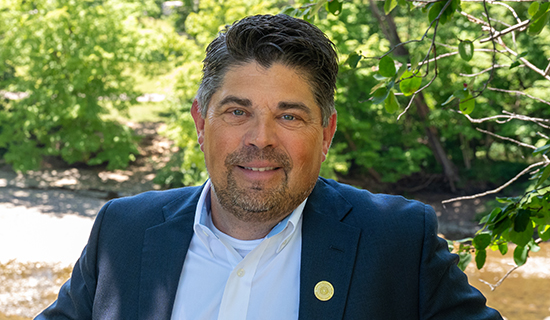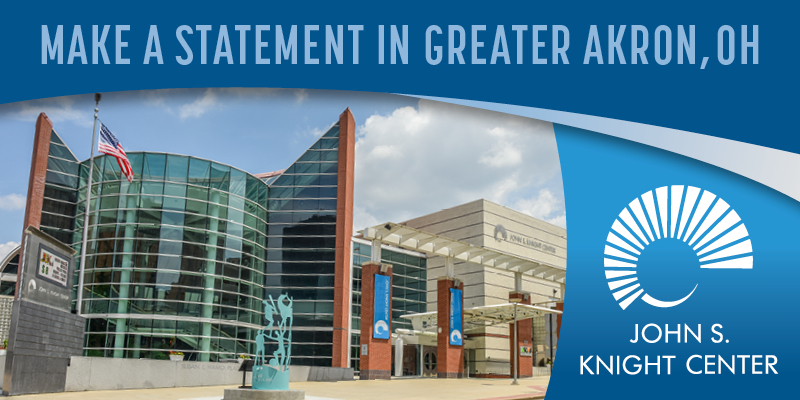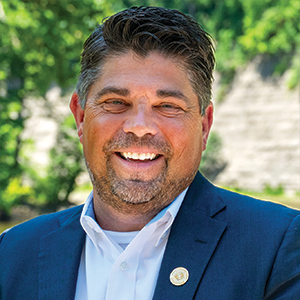Brian Zimmerman fondly remembers his first visit to the Cleveland Metroparks on a cold, gray day in November 2009, when he toured several scenic spots like the Rocky River Reservation before interviewing for the position of Cleveland Metroparks CEO. Looking out across the fading fall foliage, “it was hard not to be impressed with Cleveland’s park system,” he recalls. “My first impression was, ‘Wow.’”
Having lived in Wisconsin and Michigan, Zimmerman wasn’t familiar with the beauty or the breadth of Cleveland Metroparks, which at that time spanned just over 21,000 acres throughout Northeast Ohio. He quickly picked up on “the sense of pride that people have in the parks,” he says. That pride, coupled with the network of support the park district had built throughout the surrounding communities, convinced Zimmerman that “this is a once-in-a-lifetime job,” he says — and not just because he gets to spend some days outside of the corporate office, touring the district’s expanding domain.
Since assuming the role of CEO in March 2010, Zimmerman has led the acquisition of nearly 4,000 additional acres, including the transformation of nearly 750 acres along the lakefront, bringing Cleveland Metroparks’ total territory to over 25,000 acres today.
Based on these numbers, Zimmerman’s rate of acquisition stands second only to Cleveland Metroparks’ founder, William Stinchcomb, who built the system up to nearly 15,000 acres from the original three-acre plot where the park began: in the Rocky River Reservation that marked Zimmerman’s first visit.
“When you look at what this system was and what it’s grown into, it’s truly remarkable,” Zimmerman says. “This is a very well-thought-out, well-executed park system, and the research backs it up.”
Earning three national gold medals for best managed park district in the country from the American Academy for Park and Recreation Administration prior to Zimmerman’s arrival, and two more under his administration in 2016 and 2021, the award-winning Cleveland Metroparks are attracting attention and guests from coast to coast as its footprint and reach continue to expand.
ADVERTISEMENT
To conserve and protect
Like Zimmerman, many Ohio residents, tourists and passersby have fond memories of their experiences in the Cleveland Metroparks, which today spans 18 reservations, nine golf courses, eight lakefront parks, five nature centers, a nationally acclaimed zoo, and several restaurants and marinas. From the shorelines along Lake Erie to the river valleys, trails, forests and greenspaces that surround the city — forming a loop known as the Emerald Necklace — the sprawling park system has become an integral part of the region’s identity, not to mention a major tourist attraction.
“From the first three acres to the very last acre we’ve acquired, our goal for over a century has been to protect the lands that we’re entrusted with,” Zimmerman says. “The strategy is and has been to continue to preserve, conserve, educate, and provide recreation opportunities.”
As only the sixth leader in Cleveland Metroparks’ 107-year history, Zimmerman is not far removed from the mission of protecting nature, connecting communities and inspiring conservation.
“They’re not just buzzwords; they’re things that we live and breathe,” he says.
Soon after he was sworn in as CEO, for example, Zimmerman began crafting a strategy to acquire more lakefront properties, with the goal of further encircling the contiguous Emerald Necklace.
“We looked at the stewardship of what was affectionately called the Lakefront Park Collection that included Edgewater Park, Whiskey Island, East 55th [Street Marina], Gordon Park, Villa Angela, Euclid [Beach Park] and Wildwood,” he says. “We wanted to recapture those parks [from the state of Ohio] and return to a local management structure.”
In 2013, Cleveland Metroparks entered a 99-year lease with the city of Cleveland to manage and enhance these lakefront properties — adding several hundred acres to the park system that year. The Acacia Reservation in Lyndhurst also joined the district around that time, adding another 155 acres of greenspace along Euclid Creek to conjoin with the Euclid Creek Reservation.
With a focus on conserving land around the region’s critical waterways, Zimmerman says this early growth strategy “follows William Stinchcomb’s theme of protecting headwater streams,” which is “wildly important because our drinking water comes from those areas, and all the water that sits in this basin essentially returns to Lake Erie,” he says. “From a water quality standpoint, being able to protect those areas is key.”
Connecting communities
Cleveland Metroparks’ mission isn’t just to preserve and protect the region’s natural resources in isolation, but to connect the surrounding communities to these serene greenspaces and all the opportunities they offer for respite and recreation.
In that sense, what the parks provide is “a sense of connectedness,” Zimmerman says. “People want to be connected to water. They want to be connected to greenspace, and this system provides that like no other.”
Still, Zimmerman and other local leaders recognized plenty of potential to improve connectivity between the suburbs and the surrounding parks and trails. This prompted a county-wide planning effort coordinated by the Cuyahoga County Planning Commission, Cleveland Metroparks and the Northeast Ohio Areawide Coordinating Agency (NOACA) with funding from NOACA’s Transportation for Livable Communities Initiative. The resulting Cuyahoga Greenways Plan, adopted by NOACA in January 2020, envisions an integrated system of on-road bike paths and off-road, all-purpose trails that link the parks to public transit, population centers and employment hubs across Northeast Ohio, expanding mobility options and accessibility throughout the county.
“The Cuyahoga Greenways Plan lays out the roadmap of how we’re going to continue to connect communities,” Zimmerman says. “Whether you’re 8 years old or 80, you should be eight or 10 minutes away from a high-quality greenspace.”
Over the last decade, Zimmerman has strategically extended park access to 49 communities across six counties, adding more than 60 miles of trails to the system, which now spans more than 325 miles of trails. Since 2015, the district has improved park access by more than 15 percent, up to 25 percent in some areas. And more connections are coming soon, as Cleveland Metroparks recently received a $19.5 million federal grant — the largest in the park district’s history — to fund construction of two East Side trail projects included in the Greenways Plan.
“The community wants to see Cleveland Metroparks do more,” Zimmerman says. “They want to see the lakefront preserved, and they want to see more trails. That’s why part of our mission is connecting communities. It doesn’t matter whether you’re an east-sider or a west-sider; you can be 10 or 15 minutes from downtown and you’re in a green oasis.”
Unplugged in nature
Growing up on a farm in rural Wisconsin, Zimmerman spent a lot of time outside. But he realizes that times have changed, and instead of the party-line telephone and three-channel television he grew up with, kids today are surrounded by more devices and distractions. The challenge is to keep Cleveland Metroparks relevant by keeping the next generation engaged.
To that end, education is a top priority to teach kids about the value of nature. Between the Cleveland Metroparks Zoo and the rest of the parks district, nearly 150 dedicated full-time and part-time educators share their love of nature with young guests.
“Whether it’s a visit to the zoo or the Watershed Stewardship Center where different grade levels come through for education programs,” Zimmerman says, “we work very hard at bringing up the next generation.”
The Watershed Stewardship Center, located in the West Creek Reservation, is the first Cleveland Metroparks facility dedicated to scientific research, offering science-based programs that invite students, teachers and other curious residents to learn about stormwater management.
Zimmerman also highlights the Kids Nature Lunch & Learn Series, a summer program that provides hands-on learning opportunities through Cleveland Metroparks’ mobile nature center, with free lunch provided through the Greater Cleveland Food Bank’s Summer Feeding program. Now in its third year, the program educated more than 2,000 kids and served more than 1,100 lunches in 2023.
But it’s not just for kids; Zimmerman wants to make Cleveland Metroparks equally exciting for all ages.
“Whether you’re an infant or you’re in your mature years, we have something to offer you,” he says.
From exotic animal encounters at the zoo to fishing, hiking, kayaking, biking, skiing, golfing, birding and beaching in the great outdoors, Cleveland Metroparks offers countless opportunities for adventure, with more than 25,000 acres to explore and “hopefully unplug for a few hours,” Zimmerman says.
While promoting parks as a place to unplug and unwind, Cleveland Metroparks is also embracing digital tools to engage guests,, like a trail app to help them navigate the expanding park district and an ecommerce store where they can purchase merchandise that supports the park’s mission.
In this internet-dependent age, Zimmerman says, the Cleveland Metroparks must balance “on-demand nature” experiences with user-friendly interactions online. “We use our social media platforms better than any park district in the country to engage people in unique ways,” he says, referencing an independent study that ranked Cleveland Metroparks’ social media engagement above any other park district in the nation, with more than 1 million followers across more than a dozen social media platforms.
As much as he loves to see guests unplug entirely to explore nature, Zimmerman also loves to see people sharing photos online of their scenic hikes and wildlife sightings.
Making an impact
A 2018 study by The Trust for Public Land found that Cleveland Metroparks contribute at least $873 million in economic value each year. Since then, Zimmerman estimates that the impact has probably grown closer to $900 million as the park district has expanded and enhanced its amenities to attract more than 19 million visitors each year.
The same study also found that the park system increases the value of neighboring residential properties by $155 million. Besides giving residents access to trails and recreational amenities, the riparian zones protected by the park district also contribute to air and water quality in the community — providing stormwater infiltration valued at more than $20 million annually and reducing pollution costs by more than $8 million a year, according to the study.
“Essentially, our trees act as the lungs, and our lands act as the kidneys and liver to make this ecosystem more green and sustainable,” Zimmerman says.
A key ingredient in Cleveland Metroparks’ ongoing growth and impact is the network of partnerships and volunteers throughout the community that support its strategic plan.
“Our goal is to be the guiding force for this region in greenspace preservation and connection,” Zimmerman says, “but we don’t do this alone. We are blessed with a tremendous amount of partnership and support.”
That support comes from groups like the West Creek Conservancy and Western Reserve Land Conservancy as well as NOACA and the Cleveland-Cuyahoga County Port Authority — along with individual members of the community who volunteer their time as trail ambassadors, attend monthly public meetings to share ideas and feedback, or vote in favor of Cleveland Metroparks initiatives. For example, in 2022, voters in Cuyahoga County and Hinckley Township passed a 10-year replacement levy with 77 percent voter approval — the highest approval rating of a county-wide ballot in the history of Cuyahoga County.
“That’s a pretty impressive stat,” Zimmerman says, “and that’s not lost on any of our employees, just how much people believe in Cleveland Metroparks.”
With several projects underway to continue enhancing aging facilities, expanding amenities and extending the Cleveland Metroparks’ reach throughout the community, Zimmerman sees plenty of opportunity to boost the system’s value and impact as its footprint continues to grow.
“To be very frank, it’s less about how many acres we’ve preserved; it’s where we preserve them and why,” he says. “One of the things we’re very keen on is that they’re not making more land. And so, when you look at our ability to preserve, conserve and protect for future generations, that will be the lasting legacy that we will leave behind.”



